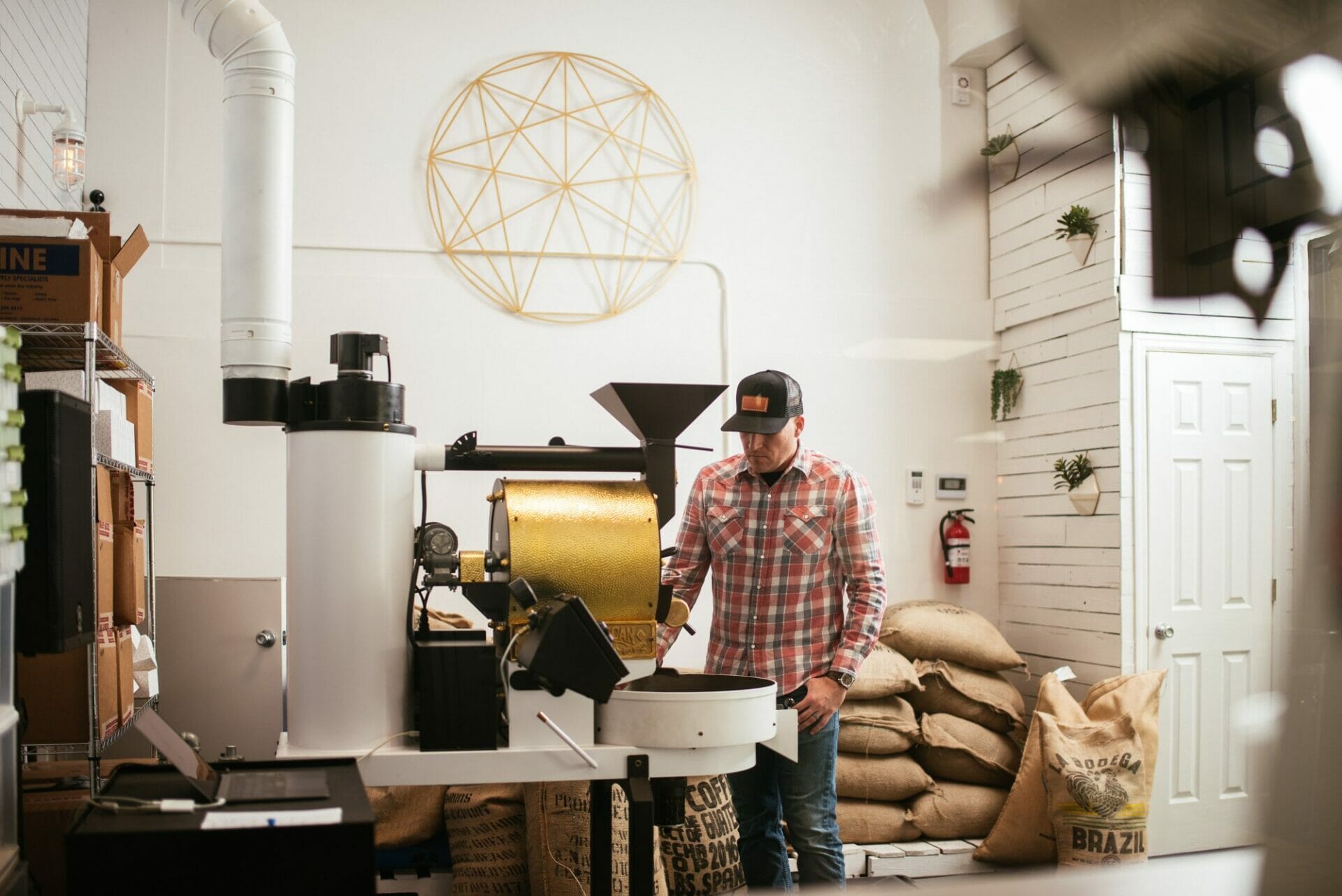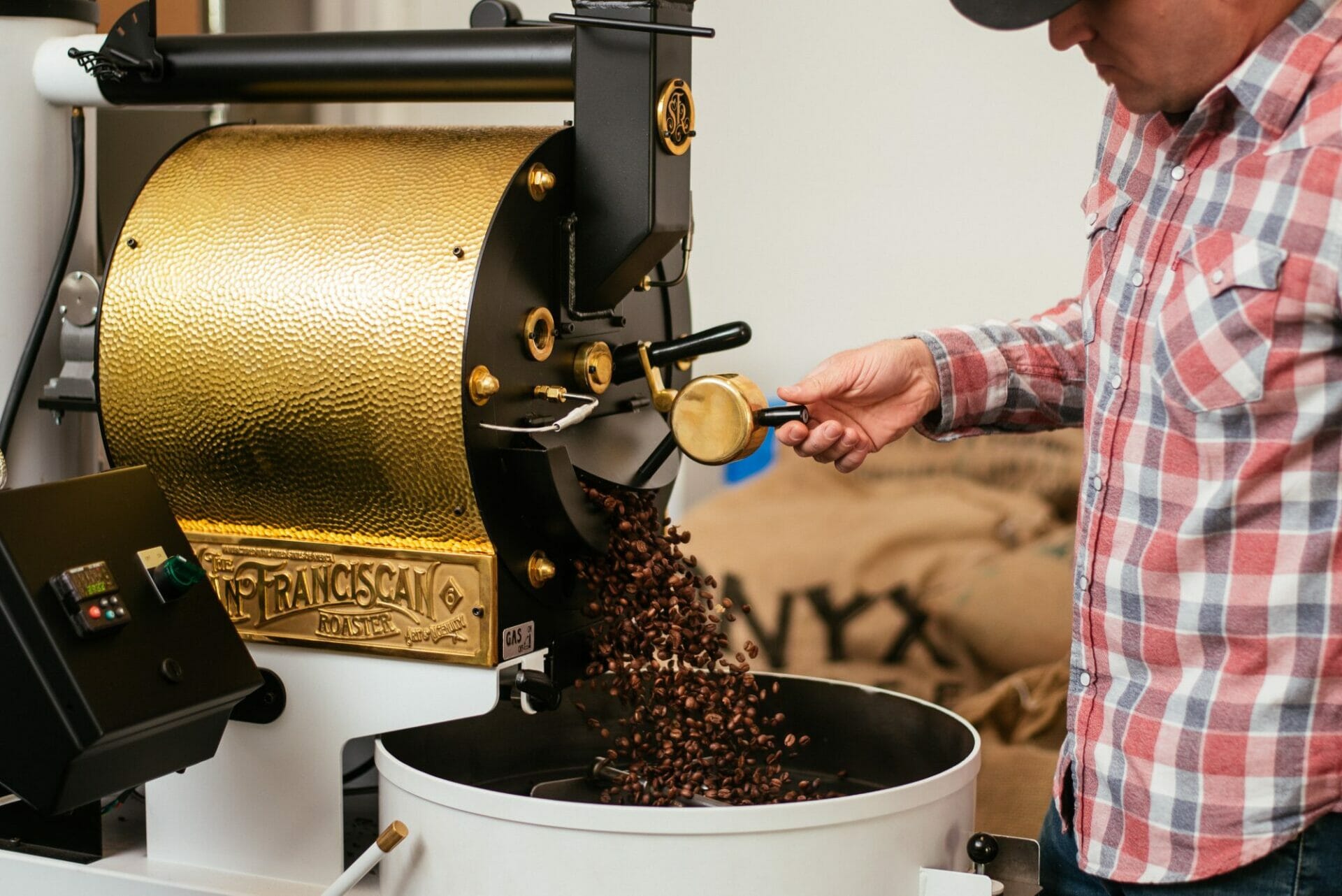As coffee roasting has become a widely embraced craft, the potential of a simple cup of coffee has quickly evolved. When Concord Coffee opened, it awakened local taste buds to the rich flavors and aromas of craft coffees nationwide. Now, with an inhouse roaster, Concord presents this in its freshest, most accessible, and even integral form.
Photos by Naomi Vacaro
In recent years, a conscious national effort has been raised to not only care about what’s on our plates, but how it got there. For humanitarian reasons and equally for a quality factor, we’re not only more concerned, but more fascinated and entertained, with how a meal gets to our table.
For most of us, we don’t care how it gets there, but most days we like our cups filled with coffee. Truth be told, maybe we’re even a little entitled to think our cups should always be filled with the finest of coffees. (I should know.)

Just as there is a farm-to-table process, there is a farm-to-cup process.
A part of Lakeland these past two years, Concord Coffee has progressed from selling nationally renowned craft coffee to now producing its own.
“Having a product that was our own was always very important,” says TJ Zimmerman, co-owner of Concord Coffee along with his wife, Lindsay; Andy and Ashley McEntire; and Bryan and Emily Ley. Since opening in 2015, the team has continued to build upon the dream, now roasting and selling their very own craft coffee here in Lakeland and online.
“That was always a part of the plan,” says Zimmerman, “but we also are still a multi-roaster, so we have other roasters we use currently in this shop. And our intention is to stay that way in this location.” When Concord Coffee opened in Lakeland, it introduced many to a world of tastes they had yet to encounter. Now it brings the full coffee bean evolution for locals to see and experience.
GLASS-ENCASED ROASTER
When you step out of the shop, just feet away to the right is a glass room, and encased in it sits the San Franciscan roaster — an American-made, handcrafted, shiny, golden, propane-fueled stately piece of machinery.
When the company had to land on the right machine, it was pretty much a forgone conclusion. “It was kind of one of those ‘it-felt-right’ moments,” says Zimmerman.
The roaster’s location was not only chosen due to its proximity to the coffee shop, but also for the roasting process to be observed from its very origin. “We want people to be able to see it and experience it,” says Zimmerman, “because it is different and unique. Most of the time, people don’t know the process.”
FROM THE GREEN BEAN
Batches are roasted five pounds at a time in the six-pound roaster (about 80 percent of its capacity) within approximately 15 minutes.
And the coffee arrives green. Yes, green.
Green coffee beans are poured up top, into the hopper. From there, they are released into a rotating drum, and as the drum rotates, the beans are heated underneath by a flame. Roasters have a charge temperature they’re gauging, so the coffee is dropped at a certain temperature depending on the profile of the coffee (how much density it has, how much water or moisture content). As it is in motion, the process is monitored both visually as well as from an app called Cropster.
Watching the roasting process temperature graphs on Cropster, the process is monitored with two probes. One reading shows the temperature inside the machine, while another reads the temperature of the actual beans. As roasters are able to track the heat on the computer, they are making adjustments according to the beans’ temperature, the rate at which the temperature is increasing every 30 seconds, the Rate of Rise (RoR), which essentially monitors what is going on inside of the beans during the process to help control the roast, avoid defect, and craft the most flavorful beans possible.

TRIAL AND ERROR
Needless to say, this is no simple, mindless kind of process. Which may be why Concord limits the management of its roasting process to two people: TJ Zimmerman and Amelie Haakonsen.
Originally from Detroit Michigan, Haakonsen came to Concord with nearly eight years of coffee experience under her belt. “I fell in love with the latte art side of things,” she says about first working with coffee, “which is weird for me because I’m not artistic at all. So this was kind of the first thing in my life that made me feel I’m good at something.”
And, after two years at Concord, now House Manager Haakonsen brings her experience with craft roasters and baristas, having learned many skills of the trade, as well as possessing what some at Concord would say to be “a phenomenal palate.”
“Most people learn the science side of coffee first,” admits Haakonsen, “but I learned this side of things first. And then I kind of had to dive in to extraction, science, and what that means as far as espresso goes.”
“Our goal was definitely to wait until we were ready to serve it,” says Zimmerman. “I mean, we’re serving national award-winning coffees,” pointing to their current espresso, “so we didn’t want to just say, ‘Hey, here’s ours!’ and it be nothing near the quality.”
The San Franciscan roaster was selected and bought in February of 2017. Concord’s first batch of roasted coffee was released in July as a drip. And by September the company released its new online store and roasted coffees for sale.
PROFILING
All of Concord’s coffee that’s both served and roasted in house is single-origin coffee. Meaning they are a pure extraction of one single kind of coffee, never blended with other flavors, to pull the most pure, clean, and clear tasting notes for each cup.
Concord also focuses on serving light roasted coffee, which brings out the most aromatic flavors possible and allows one to pick up the natural notes that are in that bean.
Sourced from importers such as Ally, Keffa (a specialty Ethiopian importer), and Onyx specializing in Guatemalan (which just won Roaster and Barista of the year), the types of coffees coming in are often changing. Yet the method of roasting remains meticulously closely monitored with each batch.
“I wanted not just myself in there, but [Haakonsen] as well, because she’s so good and well versed in coffee,” says Zimmerman. “So whenever we get a new coffee in, both of us are in [the roasting room] — talking about what approach do we want to do, what temperature do we want to have it at, when do we want to change the gas and air. So we’re in there profiling it together, looking at it, smelling it, as it’s roasting. So it’s not just one of us in there, but both of us.”

Currently, Concord has three different types of coffees on the market: one called Brazil Sitio Boa Esperanca, from the region of Matas De Mina, carrying chocolate, red apple, and caramel tasting notes. The Guatemala Los Dos Socios (a favorite of both Zimmerman and Haakonsen), a 100-percent bourbon coffee, comes from the regions of El Chalum, La Libertad, Huehuetenango, and holds tasting notes of blackberry, lime, and brown sugar. And their third offering, Ethiopian YirgZ, comes from Kochere, Yirgacheffe, and has notes of orange blossom, Meyer lemon, and plum.
Each coffee carries a profile, an origin, and tasting notes that separate one from the next. To complete each new coffee profile, with each batch is a cupping, a practice of observing tastes and aromas of a brewed coffee. “And in sensory tastings,” says Zimmerman, “we’ll actually go purchase the fruit it tastes like and we’ll narrow down the main flavors. It’s not a random selection or picking out flavors, notes or names. It’s all in the natural tasting notes.”
A CONSIDERATE CUP
“In a third wave coffee, there is this connection from farm to cup, where people are really able to understand and experience other people’s way of life,” says Haakonsen. “For so many people, this is their blood, sweat, and tears put into that green coffee. And now, people are able to experience every single bit of that.”
Following the process from point origin, selection, roasting, and profiling, the staff at Concord Coffee are able to understand the process first hand, and are able to truly taste and experience the results of this tediously crafted process. As conscious as Concord is of their roasting method, the company holds equally high standards for where this coffee is sourced and the work ethic of the farmers behind these green beans. One prime example of their importers is Ethiopia YirgZ, a trademarked coffee from Keffa.
The importer Keffa, which is out of Baltimore, sources their coffee from Ethiopia, where all the farmers contribute to one large, separate mill. And the different mills working on the coffee are graded and separated differently. The YirgZ coffee is called the Zero Defect Coffee, since it is sorted through three times. But it is a female-specific mill, where all of the ladies are paid two-times the average wage of normal Ethiopian pay. “So it’s life changing for the women,” says Haakonsen. “Then, in turn, we’re getting a really high-quality product out of it. For us, it’s really a cool selling point, and for them it’s literally changing their lives. We’re not just choosing coffee because it tastes good. We’re choosing coffee because it’s serving other people as well.
“At the end of the day, as far as [being] the best roasters in the world, we have no idea what we’re doing,” laughs Haakonsen. “We know what good coffee tastes like, and we know what we want our coffee to taste like. So before having an understanding of the science side of things, we knew where we wanted our philosophies to stand. We were making sure that the coffee we were sourcing were sustainable farms, where people are being treated a specific way, that the importers we were sourcing through are paying a fair wage, and other philosophies we had set in stone in sourcing coffee.”
For Concord, coffee is not only a way to awaken the senses, but to enlighten the efforts of farmers who make excellent coffee accessible to us on a daily basis. Now, following your coffee from farm to cup just may cause you to take each sip with a whole new appreciation. Particularly any cup from Concord.
